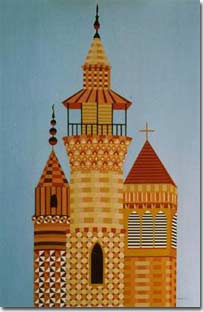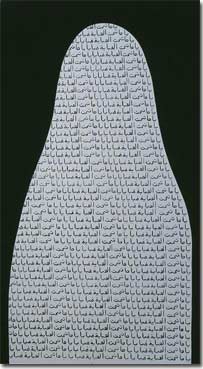Cultural Understanding in the Art of Helen Zughaib By Maymanah Farhat
In the Modern period, artists impacted by Western modes of aesthetic representation through migration, colonialism and imperialism/globalization have developed hybrid forms of art that function as tools of self-determined expression. Arab artists living in the Arab world and Diaspora are prime examples of those who have used the influence of Western schools of art combined with expressions of their cultural heritages to address issues pertinent to their communities.
Lebanese born American artist, Helen Zughaib has developed a distinct style of gouache painting, which incorporates both Middle Eastern and Western modes of representation and narrates intricate stories universal to humanity. Zughaib executes such work through a semantically-charged hybrid aesthetic that unifies her multicultural influences. Her paintings are enthused by profound cultural ties to the Middle East, recreated through memories and sensations of her birthplace into vivid compositions of delicate figures and detailed narratives.
Recently, through such paintings as Reconciliation, Secrets Under the Abaya and Another Wall, Zughaib has used her semantically-charged aesthetic to draw attention to issues imperative to Arabs and Arab Americans. Such works add dialogues of cultural understanding to American political discourse.

Reconciliation, 2003, uses recognizable attributes of Christian and Islamic architecture in a call for religious tolerance between Muslims and Christians worldwide. Two minarets are depicted alongside a church bell tower in a triangular composition that directs the viewer’s gaze to the visual similarities of the architectural features. Zughaib’s signature use of geometric patterns is executed in warm red, brown and orange motifs that vary only slightly in the adornment of all three structures.
The buildings visually compliment each other, yet each is uniquely decorated, outlining individual architectural capacities and distinctive structural designs. The visual harmony among the assembly connotes the underlying ideological parallels of the religious denominations represented by each building. The similarity of the intricate designs evokes the intertwined histories of both religions. The structures stand tall amidst a blue background that signifies peace and tranquility.
Although not overtly political in appearance, Reconciliation captures an artist’s attempt to provide an alternative discourse to the “East vs. West” divide that is propagated in political rhetoric, mass media and academia. The painting prompts the discussion of such divisionism by reminding the viewer of the historical and cultural intersections of both communities. The supposed cultural division based on ideological and theological foundations is then countered, leaving the viewer to contemplate the real reasons behind the propagation of such a divide. As Zughaib suggests, Muslims and Christians do share a complicated history. Her affirmation subsequently provokes numerous questions. What are the driving forces behind the continuous discord? Who benefits from the proliferation of such strife? Why are covert political agendas so easily fed through religious identity?

Secrets Under the Abaya, 2005, was created in response to the increasing negative perceptions of Islam and Muslim culture. Zughaib uses a limited palette of black and white, and calligraphy in what is a noticeable stylistic departure from her previous works. A silhouetted white figure is isolated in a black background so that the viewer’s gaze becomes fixated on the repetition of an Iraqi proverb written in Arabic. The proverb reads, “There are many secrets hidden under the abaya.
Many contemporary artists have explored the issue of “veiled” women in their work, yet few have taken the approach of Zughaib who presents viewers with a cultural reference that challenges them to rethink the polarization of the issue. Zughaib neither condones nor condemns the Muslim tradition; she simply provides insight into the complexity of the issue itself. With the repetition of the proverb as the focus of the painting, questions arise. What are the secrets under the abaya? More specifically, what are the social, cultural and religious experiences of Muslim women? Before assessments can be made, Zughaib urges a deeper and more nuanced examination of those experiencing the issue firsthand.
Another Wall comments on the forty-foot high Israeli “security” wall that has resulted in the annexation and destruction of Palestinian land and further suffocates human and economic life in the occupied territories. Inspired by Palestinian embroidery, Zughaib began Another Wall in early 2005. In recent history, the traditional art form has become an instrument of artistic expression, political resistance and cultural pride for Palestinian women and the self-determined movement of their people. At times when even depicting the Palestinian flag was outlawed under Israeli Occupation, embroidery functioned as a subversive tool of resilient assertion. As seen in other cases of colonized people, the local art form has taken on new meaning in a political environment that threatens the autonomy of the people.
Zughaib’s interpretation is a continual form of protest. As the “security” wall expands, new painted panels are added. Each piece is simultaneously infused with a remarkable sense of optimism and beauty capable of inspiring hope and regeneration from the ashes of sociopolitical hardship.
Another Wall contains numerous panels of 6”x6” painted canvases that are stitched together, further evoking the emulation of the folkloric tradition. Each panel is painted with detailed patterns that have been executed in vibrant color schemes. Some of the patterns are ambiguous in their cultural origins. At first glance the panels can appear to emulate the artistic traditions of numerous indigenous peoples. Within an American historical context, Zughaib’s patterns also resemble those used by Native, Latin and African American communities to affirm their cultural heritage. Though Zughaib’s patterns are Palestinian in origin, the universal appearance of her aesthetic representation unifies the Palestinian struggle with the experiences of other marginalized peoples. Although the discussion above focuses on paintings that explore political issues, Zughaib’s artistic career also includes a large body of work that depicts the heritage, history and everyday lives of Arabs and Arab Americans.
Such work simultaneously sustains the aesthetic mastery of the compositional and spatial complexity seen in 15th century Persian painting and the French Modernist School. As seen in Reconciliation, Secrets Under the Abaya and Another Wall, Zughaib’s other work also exemplifies how her painting style incorporates the use of a colorful palette reminiscent of Matisse, refined lines inspired by Mondrian, naiveté representations with the sophistication of Rousseau and folkloric themes with noticeably Middle Eastern attributes.
The juxtaposition of folkloric nuances with the appropriation of a variety of artistic practices aligns Zughaib’s work with the art of African-American and Chicano artists who continue to impact the recording of American history and the international art scene through the experiences of their communities.